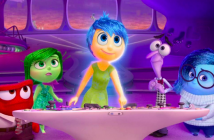Cast: Woody Allen, Diane Keaton, John Beck
Director: Woody Allen
Country: USA
Genre: Comedy | Sci-Fi
Official Trailer: Here
When asked about the future of human society, George Orwell—author of 1984—said “If you want a vision of the future, imagine a boot on a human face – forever.” When Diane Keaton’s character in Sleeper asks Woody Allen’s character if he believes there’s someone out there watching over him, he answers: “Yeah, unfortunately, it’s the government.” In article three of this spotlight on the films of Woody Allen, we see Allen’s penchant for homage, allusion and satire continuing in his fourth film, Sleeper. It’s clear that the boot and the watcher in the above statements are interchangeable images with what/whom Orwell famously dubbed “Big Brother”: an all pervading governmental, corporate and military power, which monitors and controls every aspect of civilian life. Both writers are essentially pointing in the same direction, except one of them has a wry smirk on his face.
If the spirit of the film is Charlie Chaplin meets Orwell, the actual plot (and title) is a clear reference to H.G. Wells’ The Sleeper Awakes. Allen follows the general trajectory of at least the first part of Wells’ 1910 story, where a man falls asleep for hundreds of years and is awoken in the future where he is asked to participate in a revolution. Of course, Allen’s revolution features a lot of bumbling antics performed to jazz music (which Allen wrote and performed) in scenes clearly redolent of Charlie Chaplin, the Marx Brothers and the Keystone Cops. Many would say that the scene where Allen goes out the window on the spool of automated tape is a direct reference to a scene in Chaplin’s Modern Times. Homage or not, for my money Sleeper contains some of the funniest physical comedy passages in all of cinema.
Of course, Allen’s revolution features a lot of bumbling antics performed to jazz music (which Allen wrote and performed) in scenes clearly redolent of Charlie Chaplin, the Marx Brothers and the Keystone Cops.
 In this, Woody Allen’s only traditional robot and hovercraft science fiction spoof, the plot is suitably untenable. Allen plays Miles Monroe, a health food storeowner and jazz musician—“Miles” surely not an accidental character name for a jazz musician—in 1973 who goes into the hospital for a simple peptic ulcer (an emblematic establishment of the character’s neurotic personality, which Allen often employs), and is cryogenically frozen when complications set in. Two hundred years later, a group of political resisters awaken Miles in order that he might slip through the societal loopholes and uncover the details of the mysterious “Aries Project” so that the resistance might be able to overthrow the totalitarian regime. They explain: “Everyone here has a citizen’s record. We’ve all been computerized, catalogued, fingerprinted, photographed, voice printed. But you don’t have a number. You can be used to penetrate.” Allen doesn’t skip a beat in the rhythm he’s established of alternating between serious cultural observations and pure comedy, by next having Miles explain how unfit he is for the job of intrepid rebel spy. Miles pleads with the resisters, wringing his hands: “I’m not really the heroic type. I was beaten up by Quakers.” The coward in the face of heroic duty, which we saw in his first two films, is one of Allen’s favorite shticks through which he recalls the comedy of Bob Hope. Even Allen playing Allen enjoys strumming on this riff, as he once quipped in an interview: “I was classified 4P by the draft board. In the event of war, I’m a hostage.”
In this, Woody Allen’s only traditional robot and hovercraft science fiction spoof, the plot is suitably untenable. Allen plays Miles Monroe, a health food storeowner and jazz musician—“Miles” surely not an accidental character name for a jazz musician—in 1973 who goes into the hospital for a simple peptic ulcer (an emblematic establishment of the character’s neurotic personality, which Allen often employs), and is cryogenically frozen when complications set in. Two hundred years later, a group of political resisters awaken Miles in order that he might slip through the societal loopholes and uncover the details of the mysterious “Aries Project” so that the resistance might be able to overthrow the totalitarian regime. They explain: “Everyone here has a citizen’s record. We’ve all been computerized, catalogued, fingerprinted, photographed, voice printed. But you don’t have a number. You can be used to penetrate.” Allen doesn’t skip a beat in the rhythm he’s established of alternating between serious cultural observations and pure comedy, by next having Miles explain how unfit he is for the job of intrepid rebel spy. Miles pleads with the resisters, wringing his hands: “I’m not really the heroic type. I was beaten up by Quakers.” The coward in the face of heroic duty, which we saw in his first two films, is one of Allen’s favorite shticks through which he recalls the comedy of Bob Hope. Even Allen playing Allen enjoys strumming on this riff, as he once quipped in an interview: “I was classified 4P by the draft board. In the event of war, I’m a hostage.”
Feeling he doesn’t have much of a choice, Miles stays with the resistance. As he does throughout the movie, Allen uses little crevices in the plot as moments to parody his own time period via the vehicle of the future. In this instance, his captors sit Miles down and ask him to identify various photographs of historical figures. Miles cycles through the photos giving sometimes benign and sometimes cutting commentary on his contemporaries. When the man holds up a photo of Richard Nixon, still in office in 1973, Miles responds to the photo by explaining “Whenever the president went on foreign leave, the White House staff counted the silverware.” It was a gutsy and rarely executed move back then to criticize the current president.
When the police capture the people who awakened Miles, he takes on the task they had given him and, by way of disguise, ends up as a robot servant in the wealthy household of Luna Schlosser (Keaton), socialite and poet. Here Allen skiffs from the preoccupation with politics of his early films into some of the themes that will be his mainstays through the rest of his work, including his query as to what makes real art and what makes a real artist. As it turns out, Luna has a gathering of pseudo-artists that night, which sets the stage for a one-two satirical punch. She and her friends are rich and without care: when she recites a mordantly trite poem, it becomes clear this is a group who are not only without care but also without talent. Allen takes this moment to jab at socialite artists of all media who dabble on the surface of the arts because their lives are so sheltered that they have nothing meaningful to say. Ironically, Allen was himself on the cusp of that very crux, going from mainstream darling and slapstick technician to auteur and self-possessed artist.
Here Allen skiffs from the preoccupation with politics of his early films into some of the themes that will be his mainstays through the rest of his work, including his query as to what makes real art and what makes a real artist.
 Because of the science fiction 1984-esque context of Sleeper, the scene at Luna’s permits broader socio-political annotation. All of these socialites have every distraction they need: a government issued orb that gets one high; a sex machine for mechanized intercourse; a house with robot maids; colleagues to tell one that one is talented when one is not. In this case the government has designed life, entertainment (the television is government run), sex (robbed of its power), and intoxicants that keep people safe and complacent. The question Allen seems to be posing is: how different is this from the growing level of control and manipulation in our own society? The skill of such profound commentary, on both the parts of Allen and Keaton as actors, is that it’s all done without a break in the humor.
Because of the science fiction 1984-esque context of Sleeper, the scene at Luna’s permits broader socio-political annotation. All of these socialites have every distraction they need: a government issued orb that gets one high; a sex machine for mechanized intercourse; a house with robot maids; colleagues to tell one that one is talented when one is not. In this case the government has designed life, entertainment (the television is government run), sex (robbed of its power), and intoxicants that keep people safe and complacent. The question Allen seems to be posing is: how different is this from the growing level of control and manipulation in our own society? The skill of such profound commentary, on both the parts of Allen and Keaton as actors, is that it’s all done without a break in the humor.
Miles kidnaps Luna when she discovers he’s not really a robot, and the two go on the lamb. When Luna attempts to turn Miles in, they want to arrest and reprogram her too, and so she joins forces with Miles to escape. After a hilarious flight from the police in an inflatable suit, and some light banter about God—a trademark motif which essentially manifests in this film—Allen offers another nugget of contemporary social commentary, this time about the NRA: “They were an organization that helped people get guns so they could shoot citizens. It was a public service.” Soon after, Miles is captured, reprogrammed, and given a government-issued life, while Luna escapes to the forest and becomes involved with a group of Marxist rebels living off the land.
Allen seems to be making a profound statement about the trinity of corporation, government, and religion in a scene where the re-programmed Miles visits a confessional machine and offers this confession: “Um, once this week, I questioned my supervisor. And I missed a couple of minutes of our leader’s speech on television. And, um, you know that blonde girl, Rainer, who works in my office with me, with the long blonde hair and the great tomatoes? Well, we’ve been sneaking into the slide projection room on our lunch hour and making love together. And I know if they catch us, it’s against the rules. But, uh, I can’t help it, because, um, and I hope that you forgive me.” The machine then beeps and spits out a sheet of paper, ostensibly containing his pardon. Allen seems to be saying that linking the three powers of corporation, government, and religion into a totalitarian state creates a morality that is both oppressive, and—because it’s not innate but enforced—completely disingenuous. In these moments of extreme social reflection, Allen often uses the tactic that the weightier the social commentary is, the more comedic the scene should be.
The question Allen seems to be posing is: how different is this from the growing level of control and manipulation in our own society? The skill of such profound commentary, on both the parts of Allen and Keaton as actors, is that it’s all done without a break in the humor.
 Meanwhile via the twist of the plot that lands Luna, former snob, into a back-to-the-land political group, and in a clever, writerly maneuver, Allen uses her character to illustrate the downfalls of both the conservative rich and the Marxist counterculture. In Keaton’s character Allen illustrates his opinions first of the banal, self-involved existence of the privileged, and then of the well-intentioned but unrealistic idealism of the Marxist-driven counterculture, though he clearly has a soft spot for the rebels. In fact, Marxism is one of the topics of interest that gets repeated over and again in Allen’s films: from one-liners to brief commentaries—insofar as Allen’s political discourses—Marxism is always the star.
Meanwhile via the twist of the plot that lands Luna, former snob, into a back-to-the-land political group, and in a clever, writerly maneuver, Allen uses her character to illustrate the downfalls of both the conservative rich and the Marxist counterculture. In Keaton’s character Allen illustrates his opinions first of the banal, self-involved existence of the privileged, and then of the well-intentioned but unrealistic idealism of the Marxist-driven counterculture, though he clearly has a soft spot for the rebels. In fact, Marxism is one of the topics of interest that gets repeated over and again in Allen’s films: from one-liners to brief commentaries—insofar as Allen’s political discourses—Marxism is always the star.
The plot continues absurdly when Luna and the band of rebels rescue Miles from his government-issued life and take him to live with them in the forest. In one of the funniest scenes of the movie, the rebels set about deprogramming Miles by creating a re-enactment of his family life, which inexplicably leads Miles into a passage from the cinematic version of A Streetcar Named Desire with Miles playing Blanche Dubois and Luna playing Stanley. Most notably, Keaton’s outlandish imitation of Marlon Brando is one of our first glimpses of her comedic aptitude. Allen once talked in an interview of that scene, saying that they could barely get through it because he found Keaton so funny that he kept breaking up.
At the rebel encampment Miles realizes that he has feelings for this new, liberated Luna but that she’s turned to free love and is involved in a dalliance with the rebel leader, Erno. Soon, Erno sends Luna and Miles on a mission to finally discover what the “Aries Project” is, where they find that The Leader was killed by a rebel bomb months before and the only thing that has survived is his nose; whether Allen, in his love of Freudian allusion, intended the nose as a phallic symbol, we can’t be sure. Government doctors plan to clone The Leader’s nose before the population realizes they’ve been living in an ungoverned state. Miles and Luna spring into action pretending to be doctors so they can obtain the nose and destroy it. These last scenes with Allen and Keaton acting in tandem are comedically very successful. In this—her first film with Allen directing—once Keaton is allowed to step out of the role of the un-likeable socialite, she comes into her own. The camera loves them together, and you can see the burgeoning of what they will perfect in the upcoming Love and Death, a male/female slapstick team: an almost unheard of phenomenon.
Take the Money and Run, Bananas, and Sleeper create a continuum of progress on the part of Woody Allen as a writer, director and actor. Thus far his progress has been in the form of potentially serious topics that are given a comedic treatment. In Sleeper though, Allen transitions out of a tendency to gloss deeper issues into a willingness to include moments of more weighty inquiry, even if those moments produce a laugh. A premium example of where Sleeper sits on the spectrum is the final dialogue where Keaton lobs Allen softballs that allow Allen to orate briefly on his favorite topics. As Allen does sometimes, he constructs the end of the film in a way that sets up his next movie – sort of like the idea of “a leave” in pool playing.
Keaton: Oh, I see. You don’t believe in science. And you also don’t believe that the political systems work. And you don’t believe in God, huh? So then, what do you believe in?
Allen: Sex and death. Two things that come once in my lifetime. But at least after death, you’re not nauseous.
This last dialogue “leave” not only sets up the themes and tone of his next project, Love and Death, but actually situates Keaton and Allen into conversations that they will continue there in the context of 19th century Russia.
[notification type=”star”]95/100 ~ AMAZING. Sleeper is a complex series of homages that manages to explore trenchant themes without dampening the humor. It contains some of the most successful physical comedy in cinematic history, and Allen and Diane Keaton together are a daring and entertaining pair.[/notification]



